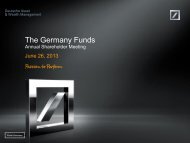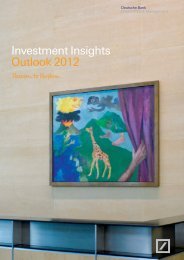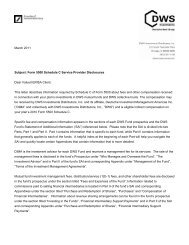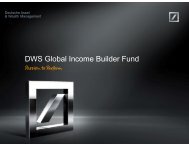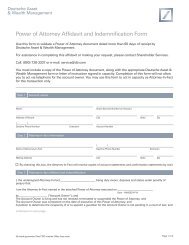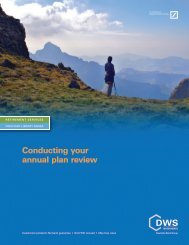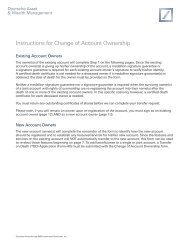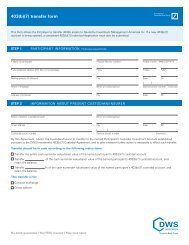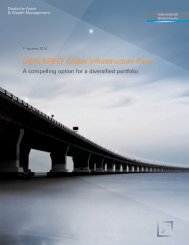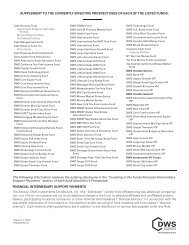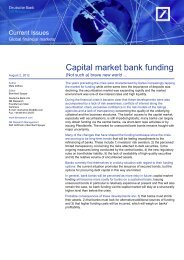2011 Tax Guide - DWS Investments
2011 Tax Guide - DWS Investments
2011 Tax Guide - DWS Investments
Create successful ePaper yourself
Turn your PDF publications into a flip-book with our unique Google optimized e-Paper software.
<strong>2011</strong> <strong>Tax</strong> <strong>Guide</strong><br />
A resource to help you with the basics<br />
Investment products: No bank guarantee I Not FDIC insured I May lose value
Table of contents<br />
We have assembled this information in an effort to help you prepare your state<br />
and federal tax returns. Any tax or legal information in this newsletter is merely<br />
a summary of our understanding and interpretation of some of the current tax<br />
laws and regulations and is not exhaustive. Please consult your legal or tax<br />
counsel for advice and information concerning your particular situation. Neither<br />
<strong>DWS</strong> <strong>Investments</strong> nor any of its representatives may give tax or legal advice.<br />
TABLE OF CONTENTS<br />
What’s new for <strong>2011</strong>............................................................................................ 3<br />
How mutual fund distributions are taxed ............................................................ 6<br />
Combined Forms 1099-DIV and 1099-B from <strong>DWS</strong> <strong>Investments</strong> ...................... 7<br />
Form 1099-DIV ..................................................................................................... 7<br />
Form 1099-B ........................................................................................................ 9<br />
Form 1099-R ...................................................................................................... 11<br />
Form 1099-Q ...................................................................................................... 12<br />
Year-end account statement .............................................................................. 13<br />
Average cost reporting ....................................................................................... 14<br />
About IRA contributions and distributions and Form 5498 ............................... 17<br />
IRS tax forms you may need .............................................................................. 18<br />
Summary of <strong>DWS</strong> <strong>Investments</strong>’ <strong>2011</strong> tax communications .............................. 19<br />
Requesting duplicate tax forms and other resources ........................................ 22<br />
2 » <strong>2011</strong> <strong>Tax</strong> <strong>Guide</strong>
What’s new for <strong>2011</strong><br />
Changes could impact your tax return<br />
New cost basis reporting requirements begin in 2012 for mutual funds. For shares of stock acquired after<br />
January 1, <strong>2011</strong> and for shares of mutual funds acquired after January 1, 2012 ( referred to as “covered<br />
securities”), the IRS requires that your financial institution report cost basis information to you and to the IRS<br />
when you sell these covered securities. Under the new requirements, mutual fund investors will have the<br />
opportunity to use the default cost basis calculation method designated for the <strong>DWS</strong> funds or elect another<br />
method. Shares purchased prior to January 1, 2012, may be eligible to receive a cost basis calculation on the<br />
shares using the “average cost” calculation method. Since the requirement does not apply to mutual funds<br />
until 2012, we will not report cost basis information from your sales of <strong>DWS</strong> <strong>Investments</strong> funds to the IRS for<br />
the <strong>2011</strong> year (although we will continue to report this information to you). As a result of these changes,<br />
you will note that some of the IRS tax forms you will fill out in preparing your <strong>2011</strong> tax return have changed.<br />
See page 7 of this <strong>Tax</strong> <strong>Guide</strong> for a more detailed discussion of the tax forms.<br />
Also, if you converted or rolled over an amount to a Roth IRA in 2010 and did not elect to report the taxable<br />
income on your 2010 return, you generally must report half of it on your <strong>2011</strong> return and the other half on your<br />
2012 return. Report the amount that is taxable on your <strong>2011</strong> return on Form 1040, line 15b (for conversions from<br />
IRAs) or 16b (for rollovers from qualified retirement plans, other than from a designated Roth account). See the<br />
instructions to the IRS forms for additional information.<br />
<strong>2011</strong> <strong>Tax</strong> <strong>Guide</strong> » 3
FILING YOUR TAX RETURN<br />
The due date for your <strong>2011</strong> individual income tax return<br />
is April 17, 2012 because April 15 is a Sunday and<br />
April 16 is Emancipation Day in the District of Columbia.<br />
Also, if you file a paper return, you may be mailing it<br />
to a different address this year because the IRS has<br />
changed filing locations for several areas. Check the<br />
instructions for IRS Form 1040 or go to www.irs.gov to<br />
find the correct mailing address for your region.<br />
TAX CREDITS FOR <strong>2011</strong><br />
The Making Work Pay tax credit has expired for <strong>2011</strong> so<br />
you can no longer claim it on your return. Schedule M<br />
is no longer in use. Other tax credits you may be eligible<br />
for were extended for <strong>2011</strong> by the 2010 <strong>Tax</strong> Relief Act.<br />
These include the $1,000 Child <strong>Tax</strong> Credit, the Earned<br />
Income <strong>Tax</strong> Credit, the Adoption Credit, the Dependent<br />
Care Credit and the American Opportunity <strong>Tax</strong> Credit<br />
for higher education expenses. In general, these credits<br />
phase out for higher income taxpayers. Please consult<br />
the IRS website at www.irs.gov for the details of these<br />
credits to determine whether they may benefit you.<br />
ITEMIZED DEDUCTIONS AND PERSONAL<br />
EXEMPTIONS<br />
The 2010 <strong>Tax</strong> Relief Act extended through 2012 the<br />
repeal of the phase out of these deductions and<br />
exemptions for higher income tax payers. For taxpayers<br />
claiming the standard deduction, it is $5,800 for single<br />
taxpayers and $11,600 for joint filers for <strong>2011</strong>. The<br />
personal exemption amount for <strong>2011</strong> is $3,700.<br />
EDUCATION SAVINGS BOND INTEREST<br />
For <strong>2011</strong>, you are able to exclude interest from<br />
certain U.S. Savings Bonds from your taxable<br />
income if you paid qualified education expenses and<br />
your income was below certain threshold amounts.<br />
See IRS Form 8815 for more details.<br />
ESTATE AND GIFT TAXES<br />
For <strong>2011</strong>, the Gift <strong>Tax</strong> rate and the Estate <strong>Tax</strong> rate<br />
and exclusion are reunified with a top tax rate of<br />
35 percent and the applicable exclusion amount of<br />
$5 million. In addition, the inflation-adjusted annual<br />
exclusion for gifts is $13,000 per donee.<br />
ALTERNATIVE MINIMUM TAX (AMT)<br />
The AMT exemption amount has increased to<br />
$48,450 for single taxpayers and $74,450 if married<br />
filing jointly or a qualifying widower in <strong>2011</strong><br />
($37,225 if married filing separately). Please visit<br />
www.irs.gov or talk to your tax advisor for details.<br />
FEDERAL TAX RATES FOR <strong>2011</strong><br />
The 2010 <strong>Tax</strong> Relief Act kept in place for <strong>2011</strong> and<br />
2012 all the Bush-era tax cuts that were originally<br />
scheduled to expire at the end of 2010. As a result,<br />
our individual tax rates for <strong>2011</strong> have a six-rate<br />
structure shown in the table below.<br />
<strong>Tax</strong> Year <strong>Tax</strong> Rates<br />
<strong>2011</strong>–2012 10% 15% 25% 28% 33% 35%<br />
4 » <strong>2011</strong> <strong>Tax</strong> <strong>Guide</strong>
<strong>2011</strong> TAX RATES FOR INCOME AND SHORT-TERM CAPITAL GAINS<br />
Personal income, including distributions from mutual funds, is currently taxed according to a rate schedule ranging<br />
from 10% to 35%, depending on taxpayer income level. Net short-term capital gains, generated by the sale of<br />
investments held by a fund or individual for one year or less, are taxed at the individual taxpayer’s income rate.<br />
10% 15% 25% 28% 33% 35%<br />
Single<br />
$0 to<br />
$8,500<br />
over $8,500 to<br />
$34,500<br />
over $34,500 to<br />
$83,600<br />
over $83,600 to<br />
$174,400<br />
over $174,400 to<br />
$379,150<br />
over $379,150<br />
no limit<br />
Married filing jointly and<br />
surviving spouses<br />
$0 to<br />
$17,000<br />
over $17,000 to<br />
$69,000<br />
over $69,000 to<br />
$139,350<br />
over $139,350 to<br />
$212,300<br />
over $212,300 to<br />
$379,150<br />
over $379,150<br />
no limit<br />
Married filing separately<br />
$0 to<br />
$8,500<br />
over $8,500 to<br />
$34,500<br />
over $34,500 to<br />
$69,675<br />
over $69,675 to<br />
$106,150<br />
over $106,150 to<br />
$189,575<br />
over $189,575<br />
no limit<br />
Head of household<br />
$0 to<br />
$12,150<br />
over $12,150 to<br />
$46,250<br />
over $46,250 to<br />
$119,400<br />
over $119,400 to<br />
$193,350<br />
over $193,350 to<br />
$379,150<br />
over $379,150<br />
no limit<br />
Note: The dollar ranges above represent taxable income. This table is for illustrative purposes only. While your income may place you within a<br />
particular tax bracket, a portion of your regular income may be taxed at a lower rate.<br />
<strong>2011</strong> TAX RATES FOR DIVIDENDS AND<br />
NET LONG-TERM CAPITAL GAINS<br />
Most dividends derived from stocks of corporations<br />
are considered “qualified dividends” and are taxed at<br />
the long-term capital gain tax rate.<br />
Individual <strong>Tax</strong> Bracket<br />
Long-term Capital<br />
Gain <strong>Tax</strong> Rate<br />
10% and 15% tax bracket 0% to 2012<br />
25%, 28%, 33% and 35% tax brackets 15% to 2012<br />
Income from bonds, real estate investment trusts<br />
(REITS), and other non corporate stock investments are<br />
nonqualified and will continue to be taxed as ordinary<br />
income, except to the extent these dividends are<br />
the product of qualified corporate dividends and are<br />
designated as such on reports to payers.<br />
HELP FROM THE IRS<br />
The Internal Revenue Service (IRS) is an excellent<br />
source for additional tax information and offers a<br />
number of helpful publications on various tax-related<br />
topics. You can obtain IRS brochures and tax<br />
forms from the IRS Web site at www.irs.gov or<br />
request free copies by calling the IRS toll-free at<br />
800-TAX-FORM (800-829-3676). Below is a<br />
sampling of IRS publications you might find useful:<br />
Title<br />
Publication<br />
Number<br />
Individual Retirement Arrangements (IRAs) 590<br />
Foreign <strong>Tax</strong> Credit for Individuals 514<br />
<strong>Tax</strong>able and Nontaxable Income 525<br />
Investment Income and Expenses 550<br />
<strong>2011</strong> <strong>Tax</strong> <strong>Guide</strong> » 5
How are they taxed<br />
Understanding how mutual fund distributions are taxed<br />
If you received a distribution from your mutual fund during <strong>2011</strong>, you’ll need to report it on your<br />
<strong>2011</strong> tax returns. These distributions must be reported to the IRS whether you received them in cash<br />
or reinvested them in additional fund shares.<br />
Mutual funds must distribute substantially all of their<br />
ordinary income and net capital gains to shareholders<br />
by the end of December in order to obtain favorable<br />
tax treatment. For tax purposes, there are two types<br />
of taxable mutual fund distributions:<br />
Ordinary (income) dividends—collectively, the<br />
interest, dividends and short-term capital gains earned<br />
by a mutual fund’s portfolio holdings.<br />
Capital gain distributions and qualified dividends—<br />
long-term capital gains generated by a fund’s profits<br />
from the sale of holdings that have appreciated in<br />
value and qualified dividends eligible for taxation at<br />
lower capital gain rates.<br />
Long-term capital gains are the net realized profits<br />
from the sale of investments held for more than one<br />
year; short-term capital gains are the net realized<br />
profits from the sale of investments held by a fund for<br />
one year or less.<br />
While not reportable as dividend income in <strong>2011</strong>,<br />
you should reduce your cost basis (generally equal<br />
to the amount you paid for your shares) by the<br />
amount of the nondividend distribution. It is important<br />
to retain a record of such distributions so you can<br />
properly calculate your gain or loss when you<br />
redeem your shares. If you use the information on<br />
<strong>DWS</strong> <strong>Investments</strong>’ average cost statement to prepare<br />
your tax return, your gains or losses will automatically<br />
reflect this adjustment.<br />
TAX EXEMPT INTEREST<br />
If you held shares of a <strong>DWS</strong> tax-free fund during <strong>2011</strong>,<br />
any interest income that was derived from municipal<br />
bonds will be reported to you on Form 1099-INT in<br />
Box 8. This amount is generally not subject to regular<br />
federal income tax, but depending on where you<br />
live, a portion may be subject to state income tax.<br />
Information on state reporting will be provided to you<br />
in the <strong>Tax</strong> Update newsletter that you will receive with<br />
all applicable tax forms for your <strong>DWS</strong> fund accounts.<br />
NONDIVIDEND DISTRIBUTIONS<br />
If your <strong>DWS</strong> <strong>Investments</strong> fund paid nondividend<br />
distributions (return of capital) during <strong>2011</strong>, they are<br />
reported in Box 3 of Form 1099-DIV.<br />
Additionally, it is important to note that if you are<br />
subject to the federal Alternative Minimum <strong>Tax</strong>, you<br />
will be required to report the amount in Box 9 of<br />
Form 1099-INT entitled, “Specified Private Activity<br />
Bond Interest” on your federal income tax return.<br />
6 » <strong>2011</strong> <strong>Tax</strong> <strong>Guide</strong>
What do the tax forms tell you<br />
Forms 1099-DIV and 1099-B from <strong>DWS</strong> <strong>Investments</strong><br />
Income dividends, short-term and long-term capital gains, foreign tax paid and nondividend distributions<br />
are just some of the information provided on your tax forms.<br />
FORM 1099-DIV<br />
The 1099-DIV lists the total fund distributions you<br />
received in <strong>2011</strong>, plus other reportable information<br />
including liquidation distributions if any paid by the<br />
fund. Distributions could include income dividends,<br />
long-term capital gains, and nondividend distributions<br />
(return of capital).<br />
On occasion some tax-free funds may reclassify a<br />
portion of their tax-free income dividend distributions<br />
as taxable. In that case, a 1099-DIV tax form will be<br />
issued to reflect the reclassified income. In addition,<br />
a capital gain may be paid out that will result in a<br />
1099-DIV being generated for your tax-free fund.<br />
A capital gain distribution occurs when some of the<br />
bonds in which the fund invested were sold at a higher<br />
price than the adjusted cost at the time of sale.<br />
The amount of your federally tax-free income dividends<br />
paid to your <strong>DWS</strong> <strong>Investments</strong> tax-free fund account(s)<br />
will also be reflected on the year-end account statement<br />
for each of your tax-free funds held during <strong>2011</strong>.<br />
Note: When completing IRS Form 1040, you’ll need<br />
to include any 1099-DIV information you receive from<br />
other investment firms with which you may have<br />
accounts. Listed on the next page is information about<br />
the various parts of Form 1099-DIV. See page 20 for a<br />
sample of Forms 1099-DIV and 1099-B.<br />
Box 1a: total ordinary dividends—includes the<br />
total of your income distributions and short-term<br />
capital gain distributions (other than tax-free income<br />
paid by <strong>DWS</strong> <strong>Investments</strong>’ municipal bond funds)<br />
that are taxable.<br />
■ If you are required to complete Schedule B of<br />
Form 1040, report this total on Line 5 in Part II<br />
of that form<br />
■ If you are not required to complete Schedule B,<br />
report this amount on Form 1040, Line 9a<br />
Note: If you received a Form 1099-DIV for <strong>2011</strong>,<br />
remember to file IRS Form 1040 or Form 1040A.<br />
The IRS does not allow these distributions to be<br />
reported on Form 1040EZ.<br />
Box 1b: qualified dividends—shows the amount in<br />
Box 1a that may be eligible for the lower capital gains<br />
rates. Report the eligible amount on Line 9b, Forms<br />
1040 or 1040A. Note that you may need to reduce the<br />
amount in Box 1b to reflect your personal tax situation<br />
(e.g., if you did not hold the fund shares generating the<br />
dividend for more than 60 days).<br />
<strong>2011</strong> <strong>Tax</strong> <strong>Guide</strong> » 7
Box 2a: total capital gain distributions—represents<br />
the total long-term capital gain distributions paid to<br />
your account. Depending on your circumstances,<br />
there are two places you might report capital gain<br />
distributions on your IRS federal tax forms:<br />
■ Report capital gain distributions on your IRS forms<br />
1040 or 1040A in addition to Schedule D, if required<br />
■ If you are not required to file Schedule D, you can<br />
report these amounts directly of Form 1040, line 13 on<br />
Form 1040 A, line 10. Please see the form instructions<br />
to determine if you must file Schedule D<br />
Box 3: nondividend distributions—represents the<br />
portion of total distributions from a fund that is treated<br />
as nontaxable (return of capital). This amount is not<br />
currently taxable, and you are not required to report it<br />
on your tax return unless your basis is reduced to zero.<br />
Box 4: federal income tax withheld—if federal<br />
income tax was withheld from any of your <strong>2011</strong><br />
distributions, the withholding amount appears here.<br />
By law, we must withhold federal tax from your account<br />
if you have not provided us with a certified Social<br />
Security number or taxpayer identification number.<br />
Box 6: foreign tax paid—if taxes were owed to<br />
foreign governments on income received from a<br />
<strong>DWS</strong> <strong>Investments</strong> fund’s foreign holding, the fund<br />
paid these taxes. If an amount appears in Box 6 of<br />
your <strong>DWS</strong> <strong>Investments</strong> 1099-DIV, your fund paid such<br />
taxes and elected to pass through to shareholders a<br />
proportionate amount of the foreign taxes it paid. This<br />
amount may be claimed as an itemized deduction or<br />
tax credit on your federal tax return. See the following<br />
page for additional details.<br />
Box 8 and Box 9: liquidation distributions—<br />
if you received liquidating distributions from<br />
<strong>DWS</strong> RREEF Real Estate Fund, Inc. or <strong>DWS</strong> RREEF<br />
Real Estate Fund II in <strong>2011</strong>, such amounts will be<br />
reported in Box 8 or Box 9 of Form 1099-DIV. For<br />
specific information regarding the tax treatment and<br />
reporting of such distributions (as they apply to your<br />
individual situation), please consult your tax advisor.<br />
As you would with taxes withheld from a payroll<br />
check, claim these amounts on your individual tax<br />
return as follows:<br />
■ Add the amount to any federal withholding amounts<br />
shown on your W-2 and other 1099 forms and<br />
report it on IRS Form 1040, Line 62<br />
8 » <strong>2011</strong> <strong>Tax</strong> <strong>Guide</strong>
FORM 1099-B<br />
Reporting gains and losses from your mutual<br />
fund transactions<br />
If you redeemed or exchanged shares from a<br />
non-money market account during <strong>2011</strong>, a record of<br />
any redemption(s) or exchange(s) will be listed on<br />
the 1099-B form. Generally, this information is used<br />
to calculate your gain or loss on redemptions of fund<br />
shares for tax purposes and must be reported on<br />
Form 8949 of Form 1040 (sales and other dispositions<br />
of capital assets). For details on reporting this<br />
information on your tax return, see the IRS instructions<br />
for Schedule D (Form 1040).<br />
The following is among the information that will be<br />
referenced on the form—beginning with <strong>2011</strong> tax forms<br />
when all information is available to calculate average cost<br />
on <strong>DWS</strong> fund shares—and with 2012 tax forms for all<br />
shares purchased on or after January 1, 2012 and sold:<br />
Box 1a: sale or exchange date—reflects the date that<br />
you exchanged or redeemed your <strong>DWS</strong> fund shares.<br />
Box 3: cost or other basis—reflects the average cost<br />
basis for <strong>DWS</strong> fund shares exchanged or sold during<br />
the course of the year. If box 6 is checked, box 3 may<br />
be blank if there isn’t complete information available to<br />
calculate ‘average cost’ on noncovered shares. In <strong>2011</strong>,<br />
cost basis using “average cost” will be provided on<br />
“noncovered” shares where all information is available<br />
to calculate it. Though this information will be reported<br />
to shareholders, it will not be reported to the IRS.<br />
Box 4: federal income tax withheld—reflects<br />
back-up withholding amount if no taxpayer identification<br />
number has been provided for your <strong>DWS</strong> fund account.<br />
Box 5: wash sale loss disallowed—represents the<br />
amount of a loss that is prohibited from being claimed<br />
as a loss due to the same shares being purchased<br />
within 30 days prior to or after a redemption<br />
transaction. Although claiming the loss is disallowed,<br />
the disallowed amount is added to the cost of the<br />
repurchased shares enabling recognition of the loss<br />
when the repurchased shares are finally sold.<br />
Box 6: noncovered securities—this box will contain<br />
a “Yes” for <strong>DWS</strong> funds in <strong>2011</strong> as fund shares<br />
purchased prior to January 1, 2012 are noncovered<br />
securities. In this case, amounts in Boxes 1b, 3, 5, and<br />
8 are not reported to the IRS for tax year <strong>2011</strong>.<br />
Box 8: type of gain or loss—reflects whether the net<br />
realized profits (or losses) from the sale of <strong>DWS</strong> fund<br />
shares was for an investment held more than one year<br />
(long-term) or for a period of one year or less (short-term).<br />
This box will not contain information for <strong>2011</strong>, but will<br />
contain information for “covered” securities beginning in<br />
2012 and each year thereafter.<br />
<strong>2011</strong> <strong>Tax</strong> <strong>Guide</strong> » 9
Need help claiming foreign tax or gain (loss)<br />
The tax form, IRS instructions and a tax advisor can help<br />
CLAIMING FOREIGN TAX PAID<br />
You may claim the amount in Box 6 on Forms 1099-DIV<br />
or 1099-INT, either as an itemized deduction or as a<br />
foreign tax credit, subject to applicable limitations, on<br />
your federal tax return. We suggest that you consult<br />
a tax advisor to determine which method is more<br />
appropriate for you.<br />
■ To claim a foreign tax credit, enter the amount from<br />
Box 6 (and any other foreign tax reported on<br />
1099 forms you receive) on IRS Form 1040, Line 47.<br />
Single filers claiming foreign tax credits exceeding<br />
$300 and joint filers claiming foreign tax credits<br />
exceeding $600 will also need to file IRS Form 1116<br />
to determine if the full amount reported in Box 6<br />
can be claimed. See the foreign tax credit table<br />
and instructions in the <strong>Tax</strong> Update <strong>2011</strong> brochure<br />
that you received with your <strong>DWS</strong> <strong>Investments</strong><br />
fund tax forms. You can get a copy of Form 1116<br />
and additional instructions from the IRS by calling<br />
800-TAX-FORM (800-829-3676) or visit www.irs.gov<br />
■ To deduct foreign taxes, enter the amount from Box 6<br />
(and any other foreign tax reported on 1099 forms you<br />
receive) on IRS Form 1040, Schedule A, Line 8, and<br />
write “foreign taxes” next to the amount<br />
For more help with foreign tax credits, see the<br />
<strong>DWS</strong> <strong>Investments</strong> <strong>Tax</strong> Update <strong>2011</strong> brochure that<br />
accompanied your <strong>DWS</strong> <strong>Investments</strong> fund tax forms.<br />
10 » <strong>2011</strong> <strong>Tax</strong> <strong>Guide</strong>
You took a distribution<br />
Form 1099-R and 1099-Q can help with next steps<br />
Look to your 1099-R and 1099-Q tax forms for information necessary to complete your tax form.<br />
THIS FORM REPORTS ALL RETIREMENT<br />
ACCOUNT DISTRIBUTIONS MADE IN <strong>2011</strong><br />
The 1099-R form summarizes the reportable distributions<br />
from your <strong>DWS</strong> <strong>Investments</strong> IRA, 401(k), 403(b) or<br />
Profit Sharing/Money Purchase Pension Plan account(s).<br />
Coverdell Education Savings Account (ESA) distributions<br />
are reported on Form 1099-Q. (Coverdell ESA<br />
contributions will be reported on Form 5498-ESA.)<br />
If you took more than one type of distribution from<br />
accounts under the same Social Security number or<br />
changed the state in which you lived when taking<br />
distributions, multiple 1099-R forms will be included.<br />
Form 1099-R contains the following information:<br />
FORM 1099-R<br />
Box 1: gross distribution—reports the total amount<br />
of money redeemed from your <strong>DWS</strong> <strong>Investments</strong><br />
retirement plan account in <strong>2011</strong>.<br />
Box 2a: taxable amount—for <strong>DWS</strong> <strong>Investments</strong><br />
Traditional IRA accounts, this is the same amount as<br />
Box 1. If you made nondeductible contributions to<br />
your <strong>DWS</strong> <strong>Investments</strong> Traditional IRA, however, a<br />
portion of this amount may be nontaxable. The IRS<br />
requires IRA investors to maintain records on the<br />
ratio of deductible to nondeductible assets. You may<br />
want to contact a tax advisor for more details. If your<br />
account is a <strong>DWS</strong> <strong>Investments</strong> 401(k), 403(b), Roth<br />
IRA, or Profit Sharing Money/Purchase Pension Plan,<br />
the taxable amount will be blank. However, we will list<br />
the taxable amount in Box 2A if your distribution was<br />
a direct rollover.<br />
<strong>2011</strong> <strong>Tax</strong> <strong>Guide</strong> » 11
Box 2b: taxable amount not determined—<br />
for distributions other than direct rollovers and excess<br />
contribution returns, this section will note whether the<br />
full amount of your account was redeemed. It will also<br />
note that <strong>DWS</strong> <strong>Investments</strong> does not determine the<br />
taxable amount of your distribution.<br />
Use the information on Form 1099-R to file your<br />
taxes by showing the taxable amount on the<br />
appropriate line(s) of IRS tax forms 1040 or 1040A.<br />
(You cannot use Form 1040EZ.) Complete instructions<br />
are provided by the IRS in the U.S. Individual Income<br />
<strong>Tax</strong> Return instruction booklet that accompanies your<br />
1040 or 1040A.<br />
FORM 1099-Q<br />
Box 1: gross distribution—reports the total amount of<br />
money redeemed from your Coverdell ESA in <strong>2011</strong>.<br />
Box 2: earnings—reports the earnings part of the<br />
gross distribution shown in Box 1. Generally, amounts<br />
distributed are included in income, unless they are used<br />
to pay for qualified education expenses, transferred<br />
between trustees, or rolled over to another qualified<br />
education program within 60 days. Include income on<br />
the “other income” line of Form 1040, Line 21.<br />
Box 4: trustee-to-trustee transfer—reports if the<br />
distribution was the result of a trustee-to-trustee rollover.<br />
If you received an IRA distribution from another<br />
institution and rolled it over to a <strong>DWS</strong> <strong>Investments</strong><br />
IRA, you will also receive a Form 1099-R from the<br />
other institution. <strong>DWS</strong> <strong>Investments</strong> will generate<br />
a Form 5498 in May (after the April 17 deadline),<br />
which will confirm its receipt of all monies (rollovers<br />
and/or contributions).<br />
Box 5: program type—shows whether the distribution<br />
is from a qualified tuition program or a Coverdell ESA.<br />
Box 6: recipient—will be checked if the recipient of<br />
the distribution is not the designated beneficiary.<br />
12 » <strong>2011</strong> <strong>Tax</strong> <strong>Guide</strong>
Year-end account statements<br />
How long should you keep them<br />
Generally, year-end account statements should be kept for a minimum of three years following the initial<br />
tax return due date or the actual date you filed your tax return, whichever is later.<br />
This three-year period is the general statute of limitations<br />
for federal income taxes. We recommend keeping<br />
your year-end account statements for a minimum of<br />
as long as you hold your shares and ideally three years<br />
after filing any tax return to reflect the redemption of<br />
your shares. They may be helpful in determining your<br />
cost basis if you sell shares at some point in the future.<br />
Maintaining complete records will help alleviate the<br />
complications in preparing your tax returns.<br />
<strong>2011</strong> <strong>Tax</strong> <strong>Guide</strong> » 13
Cost basis reporting<br />
What is it<br />
Beginning in 2012, new cost basis reporting requirements go into effect for mutual fund shares purchased after<br />
January 1, 2012 and subsequently redeemed (“covered” shares). Cost basis can be calculated using “average<br />
cost,” the default calculation method designated for the <strong>DWS</strong> funds or by using an alternative method that you<br />
designate. Additionally, you may also be eligible to receive an “average cost” calculation on <strong>DWS</strong> fund shares<br />
purchased after January 1, 1991 up through December 31, <strong>2011</strong> and subsequently redeemed or exchanged.<br />
However, cost basis on shares purchased before 2012 are not reported to the IRS.<br />
Average cost is just one of the methods that can be used<br />
to calculate cost basis on your shares. There are other<br />
methods including specific identification or specific lot.<br />
If electing specific identification (“lot”) as your preferred<br />
primary cost calculation method, a secondary calculation<br />
method will need to be designated. Some, but not all<br />
examples of secondary calculation methods include<br />
first-in, first-out (FIFO), and last-in, first-out (LIFO).<br />
For additional information on the various cost calculation<br />
methods, visit the Internal Revenue Service Web site<br />
(www.irs.gov) or the <strong>Tax</strong> Information Center on the<br />
<strong>DWS</strong> Web site (dws-investments.com). Depending<br />
on your individual situation, certain cost calculation<br />
methods may be more advantageous for you than<br />
others. Ask your tax or legal advisor for specific details.<br />
HOW CAN YOU DESIGNATE A COST<br />
BASIS CALCULATION METHOD<br />
Designating or changing a cost calculation method on<br />
your <strong>DWS</strong> fund accounts can be completed at any<br />
time up to the trade date of the first redemption of<br />
“covered” shares. It can be designated across all current<br />
(and future) accounts, on an account-by-account basis,<br />
or at the time a redemption transaction is requested.<br />
Such designations can be made in one of two ways:<br />
1) On-line using account access.<br />
2) By mail using the Cost Basis election form<br />
which can be downloaded directly from<br />
dws-investments.com or requested to be<br />
mailed to you by calling Shareholder Services.<br />
Note: On-line registration is required for account<br />
access. Easily establish it at any time by clicking on<br />
the words “Sign In” in the upper right hand corner of<br />
the main page of dws-investments.com and simply go<br />
to “account access” to designate or change your cost<br />
calculation method.<br />
HOW WILL COST BASIS BE REPORTED<br />
Cost basis will be reported on IRS Form 1099-B. These<br />
forms will report the gross proceeds of redemptions<br />
for a given tax year in addition to any gain (loss) and<br />
will be mailed no later than February 15 each year, but<br />
can mail as early as January 31 each year. All of the<br />
information on the form including whether the cost basis<br />
is for “covered” or “noncovered” shares, can be used by<br />
you and your tax advisor when completing your<br />
IRS Schedule D and other tax forms that you may file.<br />
WHERE CAN YOU OBTAIN ADDITIONAL<br />
INFORMATION ABOUT COST BASIS<br />
In addition to information about the cost basis<br />
calculation methods on the IRS and <strong>DWS</strong> Web<br />
sites, general information about cost basis including<br />
frequently asked questions and cost basis terms<br />
can also be found in the <strong>Tax</strong> Information Center on<br />
dws-investments.com. Each January, the <strong>Tax</strong><br />
Information Center is also updated with specific tax<br />
information related to all applicable <strong>DWS</strong> funds.<br />
14 » <strong>2011</strong> <strong>Tax</strong> <strong>Guide</strong>
Cost basis<br />
General information about reporting a gain or loss<br />
COST BASIS—QUESTIONS AND ANSWERS<br />
You may save significant tax dollars by wisely<br />
choosing among the methods of computing gains<br />
and losses from the exchange or redemption of<br />
mutual fund shares. We suggest that you work with<br />
your tax advisor to determine the best strategies for<br />
your specific situation. Here are some of the most<br />
frequently asked questions about capital gains and<br />
losses, and their answers.<br />
Q: When do I have to report a capital gain or loss<br />
A: Except for exchanges from money market funds<br />
or within a qualified retirement plan account, you<br />
generally have a taxable transaction that must be<br />
reported to the IRS any time you redeem or exchange<br />
mutual fund shares. Gains or losses from redemptions<br />
or exchanges are reported on Form 8949 and,<br />
Schedule D.<br />
Q: How do I determine the amount<br />
of a capital gain or loss<br />
A: The amount of gain or loss is the difference<br />
between the amount you realize and your cost basis.<br />
The amount you realize is usually the money you<br />
receive for your shares. If you exchange shares in<br />
one fund for shares in another, the amount realized is<br />
the market value of the new shares purchased. The<br />
amount realized for both redemptions and exchanges<br />
is reported on your Form 1099-B, Box 2.<br />
Q: What is meant by my cost basis<br />
A: Cost basis is the IRS term for the amount of money<br />
you have invested in your shares. The cost basis of any<br />
shares sold is usually the original price you paid for the<br />
shares. The cost basis of any shares acquired through<br />
dividend reinvestment will equal the total dollar<br />
amount of the distributions that were reinvested.<br />
If your <strong>DWS</strong> <strong>Investments</strong> fund paid a nondividend<br />
(return of capital) distribution as reported in Box 3 of<br />
Form 1099-DIV, you may need to reduce your cost<br />
basis (generally equal to the amount you paid for your<br />
shares) by the amount of the nontaxable distribution.<br />
For more details, see “Nondividend distributions” on<br />
page 6 and talk to your tax advisor.<br />
Your gain or loss on a sale or exchange is determined<br />
by your cost basis relative to the amount realized on<br />
the sale. If you sell or exchange for more than your cost<br />
basis, you have a capital gain. If you sell or exchange<br />
for less than your cost basis, you have a capital loss.<br />
Q: How do I calculate my cost basis And if I sell<br />
only a portion of my shares, how do I determine<br />
my cost basis in those shares<br />
A: Most shareholders who have held their<br />
accounts for several years have purchased shares at<br />
different times and at various prices. This includes<br />
shares purchased through the reinvestment of income<br />
dividend and capital gain distributions, as well as any<br />
additional purchases that were made. The IRS allows<br />
you to use one of several methods to determine the<br />
cost basis of your shares when you choose to sell. If<br />
you sell only a portion of your shares, these methods<br />
enable you to determine which shares were sold and<br />
the cost basis of those shares. For shareholders who<br />
opened an account after 1991, and redeemed in <strong>2011</strong>,<br />
<strong>DWS</strong> <strong>Investments</strong> may calculate cost basis on these<br />
shares based on the single-category average cost<br />
method. For shareholders who purchase shares or<br />
open accounts on or after January 1, 2012 and redeem<br />
them thereafter, they can elect to use the default<br />
average cost method designated by the <strong>DWS</strong> funds or<br />
elect another method.<br />
<strong>2011</strong> <strong>Tax</strong> <strong>Guide</strong> » 15
Cost basis reporting<br />
Considerations before calculating your cost basis<br />
WHAT YOU MAY RECEIVE FROM <strong>DWS</strong><br />
For <strong>2011</strong>, <strong>DWS</strong> will provide average cost on accounts<br />
where the applicable information is available to<br />
calculate it. Though this information will be reported to<br />
shareholders on Form 1099-B, it will not be reported<br />
to the Internal Revenue Service. <strong>DWS</strong> <strong>Investments</strong>’<br />
average cost automatically adjusts your cost basis<br />
to include the effect of any reinvested dividends and<br />
capital gains and wash sales (certain losses which<br />
are disallowed for tax purposes). For mutual fund<br />
shares purchased in 2012 (and sold), the average<br />
cost default calculation method or a different method<br />
can be used to calculate the cost on the shares.<br />
THE METHODS OF CALCULATING<br />
COST BASIS<br />
There are a number of methods that can be used to<br />
calculate your cost basis and resulting gains and losses.<br />
Each method may give you a different tax result and<br />
can significantly impact your tax consequences. We<br />
strongly suggest that you consult your tax advisor to<br />
determine the best method for you.<br />
Average cost divides the total purchase cost of all<br />
shares held at the time of redemption by the number<br />
of shares in your account. <strong>DWS</strong> <strong>Investments</strong> uses this<br />
methodology when providing average cost information.<br />
Specific identification allows you to identify specific<br />
shares when you make a redemption. To use this<br />
method, you need to obtain written confirmation from<br />
your mutual fund or other financial services provider of<br />
the shares you specified to be sold.<br />
First-in, First-out (FIFO) identifies the first mutual fund<br />
shares purchased as the first to be redeemed. The share<br />
price of the first mutual fund shares purchased and<br />
length of time invested will be used to calculate cost.<br />
16 » <strong>2011</strong> <strong>Tax</strong> <strong>Guide</strong>
What is there to know about IRAs and taxes<br />
About IRA contributions and distributions<br />
Specific rules and requirements apply to the tax reporting of contributions and distributions.<br />
Neither regular nor rollover IRA contributions<br />
are reported on Form 1099. Instead, Form 5498<br />
(for Traditional IRA or SEP-IRA) will be mailed to<br />
shareholders by May 31, 2012 and Form 5498-ESA<br />
(Coverdell Education Savings Account) will be mailed<br />
to shareholders by May 2, 2012. Any regular <strong>2011</strong><br />
IRA contributions made through April 17, 2012, as<br />
well as any rollover contributions made in <strong>2011</strong> will be<br />
reported. When you receive this form, please review it<br />
and keep it with your records.<br />
Distributions from a Traditional IRA are generally taxed<br />
as ordinary income in the year they are received.<br />
Distributions are nontaxable to the extent that they<br />
represent a return of nondeductible contributions. The<br />
nontaxable percentage of such a distribution received<br />
in <strong>2011</strong> is determined by dividing the undistributed<br />
nondeductible contributions to all of your IRAs by the<br />
total value on December 31, <strong>2011</strong>, of all your IRAs plus<br />
any distributions received during <strong>2011</strong>.<br />
The amount of IRA distributions is reported on<br />
Form 1099-R. If you made a nondeductible IRA<br />
contribution or if you received an IRA distribution<br />
in <strong>2011</strong> and have previously made nondeductible<br />
IRA contributions, you should file Form 8606,<br />
Nondeductible IRAs, and attach it to your Form 1040.<br />
Depending on when you take an IRA distribution, an<br />
additional 10% premature distribution penalty may<br />
apply. For more detailed information about your IRA<br />
distributions, please consult a tax advisor. Distributions<br />
from Roth IRAs and converted Roth IRAs are also<br />
reported on Form 1099-R. You may be required to<br />
compute the taxable amount, if any, and include it on<br />
your income tax return.<br />
Distributions from Coverdell ESAs will be reported on<br />
Form 1099-Q.<br />
<strong>2011</strong> <strong>Tax</strong> <strong>Guide</strong> » 17
What forms may apply to you<br />
IRS tax forms you may need<br />
The IRS requires you to provide certain forms along with your tax returns. Depending on your individual<br />
situation, not all forms apply.<br />
You may or may not require the following tax forms. For more detailed information, you can visit the IRS Web site<br />
(www.irs.gov) or call the IRS at (800) TAX-FORM (800) 829-3676).<br />
IRS form you’ll need … To report … Obtained from<br />
Form 1040<br />
U.S. Individual Income <strong>Tax</strong> Return<br />
■ Total ordinary dividends if $1,500 or less<br />
■ Qualified dividends<br />
■ Total capital gain distributions (and if Schedule D is not required)<br />
■ <strong>Tax</strong>-exempt distributions<br />
■ Any federal income tax withheld<br />
■ Foreign tax paid, if claimed as a credit without filing Form 1116<br />
Form 1099-DIV, Box 1a<br />
Form 1099-DIV, Box 1b<br />
Form 1099-DIV, Box 2a<br />
Form 1099-INT, Box 8<br />
Form 1099-DIV, Box 4<br />
Form 1099-INT, Box 4<br />
Form 1099-B, Box 4<br />
Form 1099-R, Box 4<br />
Form 1099-DIV, Box 6<br />
Schedule A<br />
Itemized Deductions<br />
■ Foreign tax paid, if you choose to claim it as an itemized deduction Form 1099-DIV, Box 6<br />
Schedule B<br />
Interest and Ordinary Dividends<br />
Schedule D<br />
Capital Gains and Losses<br />
■ Gross dividends, if more than $1,500<br />
■ Capital gain distributions (from long-term capital gains)<br />
Form 1099-DIV, Box 1a<br />
Form 1099-DIV, Box 2a<br />
Form 1116<br />
Foreign <strong>Tax</strong> Credit<br />
Form 6251<br />
Alternative Minimum <strong>Tax</strong><br />
Form 8606<br />
Nondeductible IRAs<br />
Form 8949<br />
Sale and other dispositions of<br />
capital assets<br />
■ Foreign tax paid if Form 1116 required Form 1099-DIV, Box 6<br />
■ Interest from Private Activity Bonds Form 1099-INT, Box 9<br />
■ Contributions to and distributions from nondeductible IRAs Form 1099-R<br />
Form 5498<br />
■ Capital gains or losses from redemptions of fund shares Form 1099-B<br />
18 » <strong>2011</strong> <strong>Tax</strong> <strong>Guide</strong>
What you may receive from <strong>DWS</strong> <strong>Investments</strong><br />
Summary of <strong>DWS</strong> <strong>Investments</strong>’ <strong>2011</strong> tax communications<br />
This tax season, you’ll receive some or all of the <strong>DWS</strong> <strong>Investments</strong> tax forms listed below, depending on<br />
your individual situation.<br />
TAX COMMUNICATIONS<br />
Form<br />
Form 1099-INT<br />
Form 1099-DIV<br />
Form 1099-B<br />
What it reports<br />
Interest income paid by your <strong>DWS</strong> <strong>Investments</strong> tax-free fund<br />
Dividends, qualified dividends, capital gain distributions, foreign tax paid, nondividend<br />
distributions, any federal income tax withheld, and some cash liquidation distributions<br />
Proceeds from the sale of shares through fund redemptions or exchanges from<br />
non-money market accounts<br />
Form 1099-R All distributions from retirement accounts during <strong>2011</strong><br />
Form 1099-Q<br />
Form 5498/ Form 5498-ESA<br />
Payments from Qualified Education Programs<br />
Total Traditional IRA, SEP-IRA, Roth IRA and Coverdell Education Savings Account<br />
(ESA) contributions and rollovers during <strong>2011</strong>. Form 5498 (Form 5498-ESA for Coverdell<br />
ESA) will be received in May<br />
SAMPLE OF FORM 1099-INT<br />
<strong>DWS</strong> <strong>Investments</strong><br />
P.O. Box 219151<br />
Kansas City, MO 64121-9515<br />
1-800-621-1048<br />
TAX YEAR <strong>2011</strong><br />
<strong>2011</strong> <strong>Tax</strong> <strong>Guide</strong> » 19
The look of your <strong>DWS</strong> <strong>Investments</strong> tax form<br />
Specific information beginning January (or later with extension)<br />
SAMPLES OF FORM 1099-DIV, FORM 1099-B, AND FORM 1099-R<br />
<strong>DWS</strong> <strong>Investments</strong><br />
P.O. Box 219151<br />
Kansas City, MO 64121-9515<br />
1-800-621-1048<br />
SAMPLE<br />
For an<br />
explanation of<br />
Boxes 1 through<br />
6 of Form<br />
1099-DIV, see<br />
page 7 of<br />
this guide.<br />
For an<br />
explanation of<br />
Form 1099-B,<br />
see page 9.<br />
<strong>DWS</strong> Trust Company<br />
P.O. BOX 219151<br />
KANSAS CITY, MO 64121-9151<br />
For an<br />
explanation of<br />
Boxes 1, 2a<br />
and 2b of<br />
Form 1099-R,<br />
see page 11.<br />
20 » <strong>2011</strong> <strong>Tax</strong> <strong>Guide</strong>
SAMPLES OF FORM 1099-Q AND FORM 5498<br />
<strong>2011</strong> <strong>Tax</strong> <strong>Guide</strong> » 21
CONTACT US<br />
Class A, B, C, INST, M and S shareholders<br />
To request duplicate copies of <strong>DWS</strong> <strong>Investments</strong> tax forms, call our automated telephone system at (800) 621-1048<br />
for Class A, B, C, INST and M Shareholders and (800) 728-3337 for Class S Shareholders. When the automated voice<br />
begins, say “TAXFORMS.” Follow the automated prompts to login and complete your request. If you wish to speak with<br />
a customer service representative, say “REPRESENTATIVE” to be transferred to Shareholder Services. Representatives are<br />
available to assist you Monday through Friday, 7 a.m. to 7 p.m. central time.<br />
KEOGH, 401K AND 403(B) SHAREHOLDERS<br />
For information on Keogh, 401K and 403(b) plans, call <strong>DWS</strong> Retirement Services at (800) 543-5776, between the hours<br />
of 8 a.m. to 5:30 p.m. central time, Monday through Friday.<br />
IRS Circular 230 Disclosure: The information in this piece as to U.S. federal income tax considerations is not intended or written to be used, and cannot be used,<br />
for the purpose of avoiding any U.S. federal tax penalties. Each taxpayer should seek U.S. federal tax advice based on the taxpayer’s particular circumstances from<br />
an independent tax advisor.<br />
VIEW A PROSPECTUS<br />
To obtain a prospectus, download one from our web site, talk to your financial representative or contact:<br />
www.dws-investments.com or (800) 728-3337 for Class S shareholders or (800) 621-1048 for Class A, B, C and M<br />
shareholders or (800) 730-1313 for Class INST shareholders. We advise you to consider each fund’s objectives, risks<br />
and charge and expenses carefully before investing. The summary prospectus and prospectus contain this and other<br />
important information about the fund. Please read the prospectus carefully before you invest.<br />
Investment products offered through<br />
<strong>DWS</strong> <strong>Investments</strong> Distributors, Inc. Advisory<br />
services offered through Deutsche Investment<br />
Management Americas, Inc.<br />
<strong>DWS</strong> <strong>Investments</strong> is part of Deutsche Bank’s<br />
Asset Management division and, within the U.S.,<br />
represents the retail asset management activities of<br />
Deutsche Bank AG, Deutsche Bank Trust Company<br />
Americas, Deutsche Investment Management<br />
Americas Inc. and <strong>DWS</strong> Trust Company.<br />
<strong>DWS</strong> <strong>Investments</strong> Distributors, Inc.<br />
222 South Riverside Plaza Chicago, IL 60606-5808<br />
www.dws-investments.com<br />
Tel (800) 621-1148<br />
© 2012 <strong>DWS</strong> <strong>Investments</strong> Distributors, Inc. All rights reserved. CC113545 (1/12) R-9278-4



